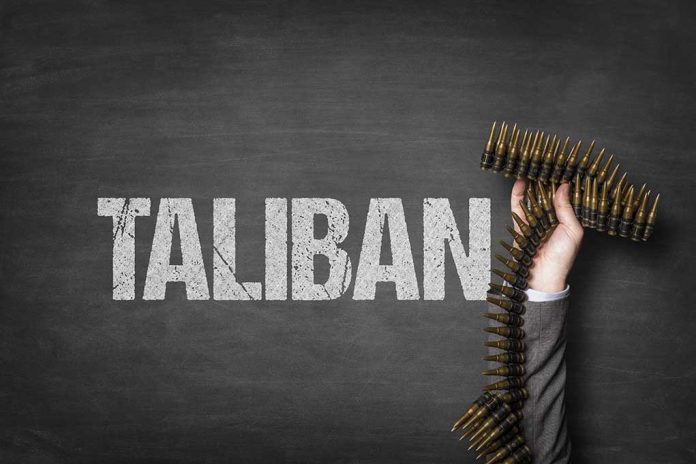
The Taliban’s $3.4 billion revenue surge has transformed Afghanistan into a global jihadist epicenter, fueled by American weapons and enriching terrorist networks with equipment valued at over $7 billion.
Key Takeaways
- Taliban revenue increased by 14% last year, reaching $3.4 billion, reinforcing Afghanistan’s role as a terror haven.
- Approximately $7.12 billion worth of U.S. military equipment remains in Taliban possession, with significant amounts transferred to terrorist groups.
- Over two dozen terrorist organizations, including ISIS-K and TTP, now operate freely in Afghanistan despite Taliban promises to prevent threats.
- The U.S. left behind substantial military assets during the 2021 withdrawal, including 78 aircraft, 40,000 vehicles, and 300,000+ weapons.
- President Trump’s administration has terminated most aid programs to Afghanistan, saving over $1 billion in taxpayer funds.
Afghanistan’s Transformation into a Terrorist Haven
Afghanistan has rapidly devolved into a terrorist breeding ground under Taliban rule, with the organization’s coffers swelling by 14% over the past year to $3.4 billion. This financial windfall has enabled the Taliban to strengthen its position while simultaneously providing a safe harbor to numerous terrorist organizations. Intelligence reports confirm that Afghanistan now hosts more than two dozen active terrorist groups, including ISIS-K and Tehrik-i-Taliban Pakistan (TTP), all benefiting from the security vacuum left by America’s withdrawal. These groups have exploited the Taliban’s willingness to distribute American weapons, creating a dangerous network of well-armed jihadists in a country that has historically served as a launchpad for international terrorism.
“Terrorist groups continued to operate in and from Afghanistan amid ongoing U.S., UN, and regional concerns that the country remains a terrorist haven,” according to the Pentagon.
Despite the Taliban’s assurances in the 2020 U.S.-Taliban Doha agreement to prevent Afghanistan from becoming a base for jihadist threats, U.S. intelligence continues to document extensive ties between Taliban leadership and al-Qaeda. The killing of al-Qaeda leader Ayman al-Zawahri in a Kabul residence in August 2022 provided irrefutable evidence of these connections. This relationship has persisted despite international pressure, with Taliban Supreme Leader Maulvi Hibatullah Akhundzada showing no intention of limiting space for terrorist organizations to operate within Afghan borders.
The American Arsenal in Taliban Hands
The disastrous withdrawal from Afghanistan orchestrated by the Biden administration left behind an enormous cache of military equipment, now repurposed to strengthen terrorist networks across the region. The shocking inventory abandoned includes 78 aircraft, 40,000 military vehicles, and over 300,000 weapons, representing a security nightmare of historic proportions. According to the Special Inspector General for Afghanistan Reconstruction (SIGAR), the Taliban now controls approximately $7.12 billion worth of American military assets. These resources have been systematically distributed to terrorist affiliates or sold on the black market, creating a dangerous proliferation of advanced weaponry among enemies of the United States.
“Terrorist groups continued to use Afghan soil to train and plan attacks, and a ‘small but steady’ flow of foreign terrorists continued to travel to Afghanistan and join one of over two dozen terror groups based there,” reported Special Inspector General for Afghanistan Reconstruction (SIGAR).
The Taliban has meticulously cataloged and redistributed these “weapons seized from the former Afghan National Army,” creating a dangerous force multiplier for terrorist operations. This arsenal includes not just small arms but sophisticated night-vision equipment, communications gear, and vehicles that enhance the operational capabilities of extremist groups. The weaponry flowing from Afghanistan now threatens stability across Central Asia and beyond, creating security challenges that will likely plague American interests for decades to come.
The Taliban’s Ideological Commitment to Jihad
The Taliban leadership has made no secret of their continued ideological hostility toward America and their commitment to global jihad. Their rhetoric reveals a fundamental incompatibility with peaceful coexistence in the international community despite occasional diplomatic overtures. The organization remains divided, with some Kabul-based leaders seeking international legitimacy while the more hardline elements in Kandahar maintain unwavering support for al-Qaeda and similar groups. This internal tension has not diminished their overall commitment to providing safe haven for jihadist organizations with anti-Western agendas.
“The infidels were not fighting us for land, for money, and for no other thing, except our ideology and faith… and they decided to suppress our ideology… and stop the jihad, ban the sharia… the fight still hasn’t ended, it still exists. And it won’t end until the day of judgement,” stated Maulvi Hibatullah Akhundzada, Taliban supreme leader.
The Taliban has consistently proclaimed victory over America, with one leader, Haji Hekmat, boldly declaring, “we have won the war and America has lost.” This triumphalist narrative fuels their confidence and emboldens their terrorist allies. Most concerning is their dual posture toward future conflict, as articulated by Hekmat: “We are ready for anything. We are totally prepared for peace, and we are fully prepared for jihad.” This calculated ambiguity allows the Taliban to engage in diplomatic talks while simultaneously strengthening terrorist networks that threaten American security interests globally.
President Trump’s Corrective Actions
The Trump administration has taken decisive steps to halt the flow of American taxpayer dollars to the Taliban regime, terminating funding for most U.S. programs in Afghanistan and saving over $1 billion. This corrective action follows revelations that the Biden administration had provided nearly $4 billion in aid to Afghanistan after the Taliban takeover, despite documented cases of fraud and mismanagement. Perhaps most disturbing was the discovery that American aid partners had paid the Taliban at least $10.9 million in “fees” to operate in the country, effectively funding the very regime that harbors terrorists targeting America.
Additional measures included freezing emergency food assistance programs due to Taliban interference and dissolving the U.S. Agency for International Development (USAID) operations in the country. The few remaining aid initiatives now focus exclusively on supporting Afghan students studying online or abroad, ensuring that American humanitarian assistance cannot be diverted to strengthen the Taliban’s grip on power. With the Special Inspector General for Afghanistan Reconstruction (SIGAR) set to cease operations early next year, President Trump’s administration continues to prioritize accountability for the catastrophic failures that allowed Afghanistan to once again become a global center for jihadist terrorism.



